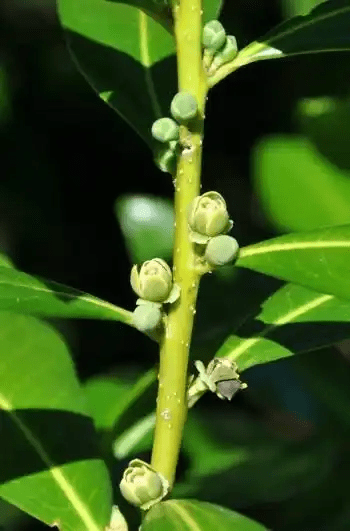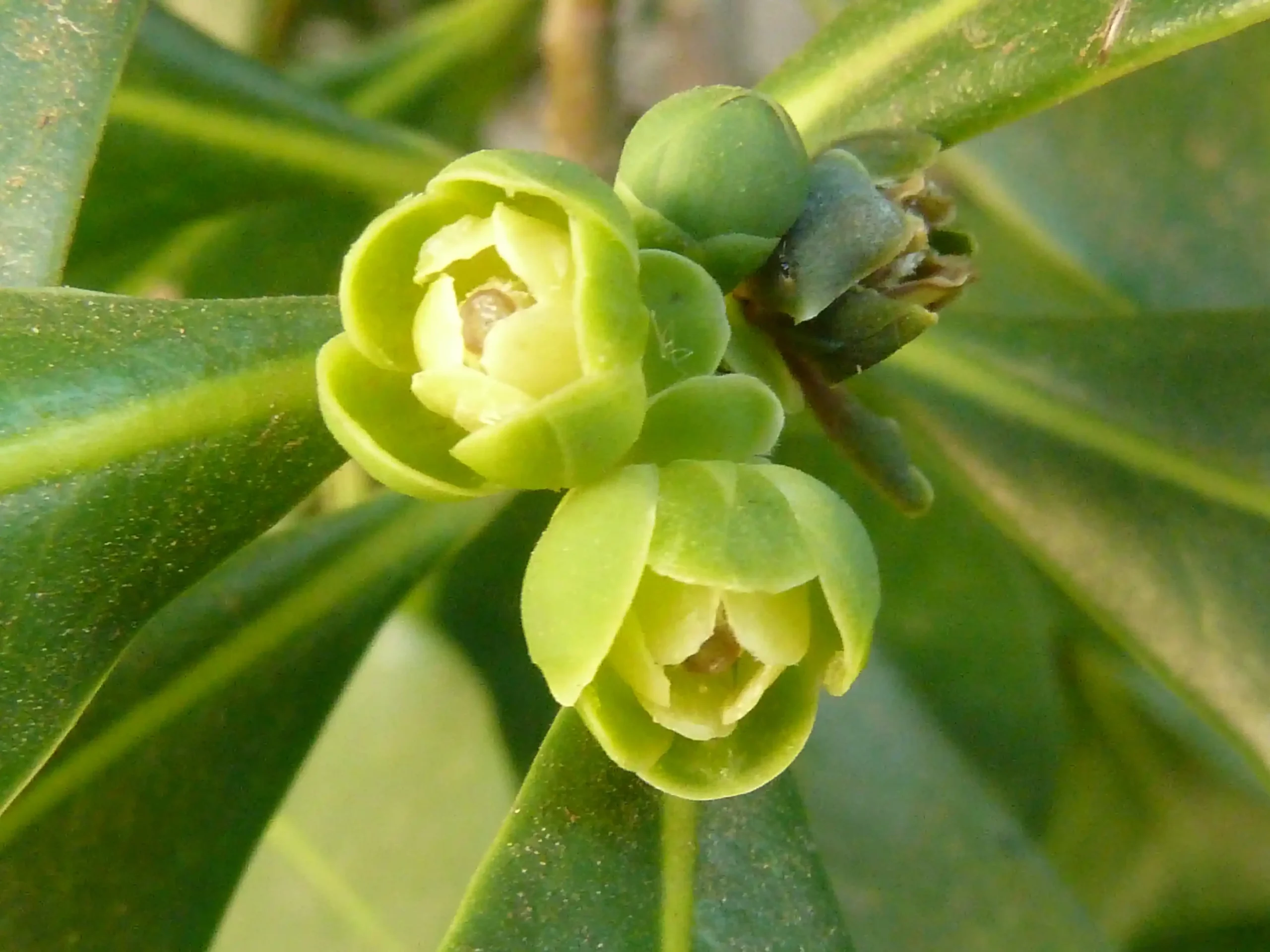Warburgia salutaris, commonly referred to as Pepper-Bark, is a tree species native to southern Africa, particularly found in countries like South Africa, Zimbabwe, Mozambique, and Swaziland. Belonging to the Canellaceae family, this tree holds significant cultural, medicinal, and ecological importance in the region.
The Pepper-Bark tree is a medium-sized evergreen tree that can reach heights of around 5 to 15 meters. It features a dense, rounded crown and bears lance-shaped leaves that emit a distinctive peppery fragrance when crushed. This aroma gives the tree its common name, Pepper-Bark.
In traditional African medicine systems, various parts of Warburgia salutaris, particularly the bark and leaves, are used for their medicinal properties.
The bark, in particular, contains bioactive compounds believed to possess potent antimicrobial, anti-inflammatory, and analgesic properties.
It has been used traditionally to treat a wide array of ailments, including respiratory conditions like coughs, colds, and bronchitis, as well as digestive issues and general pain relief. Additionally, it’s thought to have properties that support immune function and overall wellness.
The bark of Pepper-Bark is harvested for its medicinal value, which has led to concerns about overexploitation and conservation of the species. Efforts are being made to promote sustainable harvesting practices and conservation measures to preserve this valuable tree species.
Beyond its medicinal uses, Pepper-Bark contributes to the ecosystem by providing habitat and sustenance for various wildlife species. Its presence in the native flora of southern Africa enriches the biodiversity of the region.
While the traditional uses of Warburgia salutaris have been well-documented and revered in African cultures for centuries, scientific research is ongoing to better understand and validate its medicinal properties. Further studies are essential to ascertain its effectiveness and safety in treating various health conditions.
The cultural significance and medicinal value of Pepper-Bark underscore the importance of conserving and understanding the diverse flora found in southern Africa, acknowledging the contributions these species make to traditional medicine and biodiversity.
The Botanical Description of Warburgia salutaris
1. Life: Warburgia salutaris, known as the Pepper-Bark tree, is an evergreen with a straight trunk, dense foliage, and a height up to 15 meters. Bark exudes a spicy aroma.
2. Leaves: Simple, opposite, elliptical leaves with a glossy green color, contributing to the tree’s symmetry.
3. Flowers: Small, inconspicuous flowers in clusters play a crucial role in reproduction.
4. Fruits: Small berry-like fruits, not consumed by humans but vital for wildlife.
The Geographic Distribution of Warburgia salutaris
1. Native Regions: Native to Southern Africa, including South Africa, Zimbabwe, and Mozambique.
2. Preferred Climate: Thrives in subtropical and tropical climates with well-distributed rainfall.
3. Habitat Diversity: Adapts to various habitats, from mountains to coastal areas, showcasing versatility.
The Chemical Composition of Warburgia salutaris
1. Essential Oils: Renowned for essential oils in the bark, emitting a distinctive aroma.
2. Medicinal Compounds: Contains quinones, flavonoids, and alkaloids with anti-inflammatory and antimicrobial properties.
3. Antioxidant Potential: Exhibits antioxidant activity, contributing to potential health benefits.
Read Also: How to Choose the Right Crops for your Climate
The Medicinal Health Benefits Of Warburgia salutaris (Pepper-Bark)

1. Anti-Inflammatory Properties: Warburgia salutaris has been traditionally recognized for its potent anti-inflammatory effects, which may aid in the treatment of inflammatory conditions.
2. Antimicrobial Action: The plant exhibits antimicrobial properties, making it valuable in combating various bacterial and fungal infections.
3. Respiratory Health: Warburgia salutaris is known for its positive impact on respiratory health, potentially providing relief from conditions like asthma and bronchitis.
4. Digestive Support: The plant may offer digestive benefits, promoting a healthy gastrointestinal system and alleviating digestive issues.
5. Pain Relief: Its analgesic properties make it a natural choice for managing pain, both chronic and acute.
6. Immune System Boost: Warburgia salutaris is believed to strengthen the immune system, enhancing the body’s ability to fight off infections.
7. Fever Reduction: Traditionally used to reduce fevers, the plant may have a cooling effect on the body.
8. Antioxidant Defense: Rich in antioxidants, it helps neutralize free radicals, contributing to overall health and well-being.
9. Cardiovascular Support: The plant may have positive effects on heart health, including potential benefits for blood circulation.
10. Anti-Cancer Properties: Some studies suggest that Warburgia salutaris may possess anti-cancer properties, though further research is needed to confirm these findings.
11. Diabetes Management: Preliminary research indicates potential benefits in managing diabetes by regulating blood sugar levels.
12. Anti-Anxiety Effects: Warburgia salutaris may have calming effects on the nervous system, offering relief from anxiety-related symptoms.
13. Wound Healing: Applied topically, the plant may aid in the healing of wounds and skin conditions.
14. Antiviral Activity: Studies suggest potential antiviral properties, making it a subject of interest in viral infection research.
15. Hormonal Balance: Traditional uses include addressing hormonal imbalances, particularly in women, although scientific validation is needed.
16. Liver Health: The plant may support liver function, contributing to overall detoxification processes.
17. Cognitive Support: Preliminary research indicates cognitive benefits, potentially aiding in conditions like Alzheimer’s disease.
18. Anti-Arthritic Effects: Warburgia salutaris may have benefits for arthritis sufferers, including reducing inflammation and alleviating symptoms.
The Methods of Usage to Achieve the Provided Health Benefits Of Warburgia salutaris (Pepper-Bark)
1. Herbal Tea: Prepare a therapeutic herbal tea by steeping Warburgia salutaris bark in hot water, unlocking its medicinal properties.
2. Tinctures: Tinctures offer a concentrated form of the plant, allowing for easy and precise dosage.
3. Topical Applications: Create ointments or creams for topical use, beneficial for wound healing and skin conditions.
4. Capsule Supplements: Capsules provide a convenient way to incorporate Warburgia salutaris into a daily health regimen.
5. Steam Inhalation: Inhaling steam infused with the plant’s extracts can provide respiratory and sinus benefits.
6. Poultices: Apply poultices for localized relief, especially in areas affected by pain or inflammation.
7. Culinary Use: In some cultures, Warburgia salutaris is incorporated into culinary dishes for both flavor and health benefits.
8. Aromatherapy: The essential oils extracted from the plant can be used in aromatherapy for relaxation and stress relief.
9. Syrups: Prepare syrups for a more palatable way to consume the plant’s extracts, suitable for children and those who prefer a sweetened form.
10. Infused Oils: Create infused oils for massage or topical application, harnessing the plant’s therapeutic properties.
The Side Effects Of Using Warburgia salutaris Medicinal Plant
1. Allergic Reactions: Some individuals may experience allergic reactions, including skin rashes or itching.
2. Gastrointestinal Discomfort: High doses may lead to digestive issues, such as nausea or stomach upset.
3. Drug Interactions: Warburgia salutaris may interact with certain medications, necessitating caution in concurrent use.
4. Pregnancy Concerns: Pregnant women should exercise caution, as the effects on pregnancy are not well-studied.
5. Liver Health: Excessive use may impact liver health, and individuals with liver conditions should consult a healthcare professional.
6. Central Nervous System Effects: In some cases, excessive use may lead to drowsiness or sedation.
7. Bleeding Risks: Individuals with bleeding disorders should use Warburgia salutaris cautiously due to its potential antiplatelet effects.
8. Not Recommended for Children: Some forms of administration, such as tinctures, may not be suitable for children, and proper guidance is essential.
9. Limited Research: Due to limited research on its long-term effects, moderation and professional advice are crucial for sustained usage.
10. Skin Sensitivity: Topical applications may cause skin sensitivity in some individuals, and patch testing is recommended.
Read Also: How to Farm and Care for Bonga Shad Fish (Ethmalosa fimbriata)
The Scientific Research and Studies of Warburgia salutaris (Pepper-Bark)

1. Anti-Inflammatory Properties: Numerous scientific studies have delved into the anti-inflammatory potential of Warburgia salutaris, shedding light on the specific compounds responsible for its efficacy in managing inflammatory conditions.
2. Antimicrobial Action: Rigorous research has explored the antimicrobial properties of this plant, identifying its effectiveness against a range of bacteria and fungi, paving the way for potential pharmaceutical applications.
3. Respiratory Health: Scientific investigations into the impact of Warburgia salutaris on respiratory health have shown promising results, suggesting its utility in addressing conditions like asthma and bronchitis.
4. Digestive Support: Research has explored the plant’s digestive benefits, investigating its role in promoting a healthy gastrointestinal system and addressing various digestive issues.
5. Pain Relief: The analgesic properties of Warburgia salutaris have been a subject of scientific inquiry, with studies aiming to elucidate the mechanisms behind its pain-relieving effects.
6. Immune System Boost: Scientific studies have investigated the immunomodulatory effects of Warburgia salutaris, providing insights into how it may enhance the body’s immune response.
7. Fever Reduction: Research has been conducted on the plant’s ability to reduce fevers, unraveling the mechanisms that contribute to its potential antipyretic effects.
8. Antioxidant Defense: The antioxidant properties of Warburgia salutaris have been scientifically examined, highlighting its capacity to neutralize free radicals and protect cells from oxidative stress.
9. Cardiovascular Support: Studies have explored the impact of Warburgia salutaris on cardiovascular health, investigating its potential benefits for blood circulation and heart function.
10. Anti-Cancer Properties: While preliminary, research has indicated potential anti-cancer properties in certain compounds found in Warburgia salutaris, encouraging further exploration in this field.
11. Diabetes Management: Scientific investigations have begun to unravel the potential of Warburgia salutaris in managing diabetes, with studies focusing on its impact on blood sugar regulation.
12. Anti-Anxiety Effects: Research into the calming effects of Warburgia salutaris on the nervous system has opened avenues for understanding its potential in alleviating symptoms of anxiety.
The Safety Precautions and Recommendations In Using Warburgia salutaris Medicinal Plant
1. Allergic Reactions: Individuals with known allergies should exercise caution, as allergic reactions, though rare, have been reported with the use of Warburgia salutaris.
2. Dosage Guidelines: Adherence to recommended dosage guidelines is crucial to avoid potential side effects, and consultation with a healthcare professional is advised, especially when using extracts or supplements.
3. Pregnancy and Lactation: Pregnant and lactating individuals should consult healthcare professionals before using Warburgia salutaris due to limited information on its safety during pregnancy.
4. Medical Conditions: Individuals with pre-existing medical conditions, especially liver disorders and bleeding disorders, should seek medical advice before incorporating Warburgia salutaris into their health regimen.
5. Drug Interactions: Warburgia salutaris may interact with certain medications, and it’s essential to inform healthcare providers about its use to prevent potential adverse interactions.
6. Children’s Usage: Use in children should be approached with caution, and consulting with a pediatric healthcare professional is advised, considering the limited research on its effects in this population.
7. Duration of Use: Prolonged use of Warburgia salutaris without professional guidance may have unknown effects, and periodic evaluation by healthcare providers is recommended.
8. Skin Sensitivity: Individuals with sensitive skin should perform a patch test before topical application to avoid potential skin reactions.
FAQs About Warburgia salutaris Medicinal Plant
1. Is Warburgia salutaris safe for daily use?
Yes, when used in moderation and following recommended dosage guidelines, Warburgia salutaris is generally considered safe for daily use.
2. Can pregnant women use products containing Warburgia salutaris?
Pregnant women should consult their healthcare providers before using any products containing Warburgia salutaris due to limited data on its safety during pregnancy.
3. Are there any known drug interactions with Warburgia salutaris?
Yes, Warburgia salutaris may interact with certain medications. It’s crucial to inform your healthcare provider about its use to prevent potential interactions.
4. Can Warburgia salutaris be used topically for skin conditions?
Yes, Warburgia salutaris can be used topically for skin conditions, but individuals with sensitive skin should perform a patch test before widespread application.
5. Is there a recommended duration for using Warburgia salutaris?
While short-term use is generally considered safe, prolonged use without professional guidance may have unknown effects. Periodic evaluation by healthcare providers is recommended.
6. Can children use products containing Warburgia salutaris?
Use in children should be approached with caution, and consulting with a pediatric healthcare professional is advised due to limited research on its effects in this population.
7. Are there any known side effects of using Warburgia salutaris?
Potential side effects include allergic reactions, gastrointestinal discomfort, and skin sensitivity. It’s important to follow recommended guidelines and seek medical advice if adverse reactions occur.
8. Can Warburgia salutaris be used alongside other herbal supplements?
Caution is advised when combining herbal supplements, and it’s recommended to consult with a healthcare professional to avoid potential interactions.
9. Is there a specific form of Warburgia salutaris that is most effective?
The effectiveness may vary based on the form (tea, tincture, capsule, etc.) and individual factors. It’s advisable to choose a form based on personal preferences and consult with healthcare professionals for guidance.
10. How does Warburgia salutaris contribute to immune system health?
Warburgia salutaris may modulate the immune system, enhancing its response to infections. Scientific studies suggest potential benefits, but individual responses may vary.
11. Can Warburgia salutaris be used for mental health conditions?
While research indicates potential anti-anxiety effects, individuals with mental health conditions should consult with mental health professionals for appropriate guidance and treatment.
12. Are there age restrictions for using products containing Warburgia salutaris?
While generally safe for adults, caution is advised for children. It’s crucial to seek guidance from healthcare professionals for appropriate use in different age groups.
13. Can Warburgia salutaris be used alongside conventional medications?
Individuals using conventional medications should inform their healthcare providers about the use of Warburgia salutaris to prevent potential interactions.
14. Are there any known contraindications for using Warburgia salutaris?
Individuals with known allergies to the plant or its components should avoid its use. Additionally, individuals with certain medical conditions should seek professional advice before using Warburgia salutaris.
Read Also: Food Contamination/Pollution and Sources of Food Contamination

